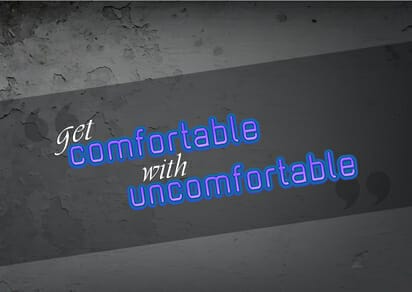 No one wants to be uncomfortable, but being uncomfortable is unavoidable. The uncomfortableness can be small or large, sudden or gradual, expected or unexpected. But there are going to be times when we’re uncomfortable, so we need to learn how to get comfortable with uncomfortable.
No one wants to be uncomfortable, but being uncomfortable is unavoidable. The uncomfortableness can be small or large, sudden or gradual, expected or unexpected. But there are going to be times when we’re uncomfortable, so we need to learn how to get comfortable with uncomfortable.
We often respond to being uncomfortable with one of 3 knee-jerk responses:
- Ignore whatever is making us uncomfortable.
- Avoid whatever is making us uncomfortable.
- Blame whatever is making us uncomfortable.
The problem with these responses is they don’t alleviate the uncomfortableness. In fact, they often make the uncomfortableness worse. Here’s why…
- Ignoring prolongs the uncomfortableness.
- Avoiding adds to the uncomfortableness.
- Blaming complicates the uncomfortableness.
So what’s a better way to respond to being uncomfortable? I often tell the people I’m counseling that they need to lean into the uncomfortable. Here are some ways to do that:
L – Learn what’s making you uncomfortable and why. So often, we try to get around being uncomfortable before we really know what’s making us uncomfortable and why. Is it something that was said? Is it the way it was said? Is it an unfamiliar task or environment? What is it about that that makes you uncomfortable? You can’t go about changing something without knowing what it is and why it makes you uncomfortable.
E – Endure the discomfort a little longer than you think you can. When you bail at the first sign of being uncomfortable, you never build your tolerance to discomfort. So when something makes you uncomfortable and you want to escape, try to stay with it a little longer than you think you can. This will not only build your tolerance for discomfort, it will build your confidence in handling discomfort.
The exception is when the discomfort is coming from something that is physically, emotionally, or sexually harmful. In those circumstances, you should protect yourself by removing yourself from the situation until the situation has been remedied.
A – Adapt your thinking and actions. Many times, being uncomfortable is a sign that it’s time to change or adapt what we think or do. It’s easy to get in a routine and continue in your same old ways of thinking and doing. But things change, and if we don’t change accordingly we get more and more uncomfortable.
N – Normalize what’s making you uncomfortable, as much as possible. Being uncomfortable is not always bad or wrong. Sometimes it’s just normal. Don’t let the discomfort lead you to “awful-ize” the circumstance. Accept it for what it is. It’s just uncomfortable.
Though it doesn’t feel like it, being uncomfortable can actually be the catalyst for something new and better in your life. My daughter recently gave birth to her second child. The week before delivery, she and her unborn child were “running out of room” and getting very uncomfortable. This uncomfortableness eventually led to the birth of a beautiful little girl. It was difficult to endure and there was some pain involved, but in the end being terribly uncomfortable brought about something new and precious.
With that in mind, here are some questions for you…
- Where is it in life that you’re uncomfortable?
- What is your discomfort trying to produce or birth in you?
- Are you uncomfortable enough to do something about it?
We all will be uncomfortable at times. The question is…will we face the discomfort and allow it to teach us, change us, and grow us?
On another level…
Scripture never tells us that we can avoid uncomfortableness. In fact, it tends to tell us that we can be certain to face it. In John 16:33, Jesus went so far as to tell us to expect it.
But Psalm 23:4 give a clue as to how we can face uncomfortable. It says…
Even when I walk through the darkest valley, I will not be afraid, for you are close beside me. Your rod and your staff protect and comfort me. (Ps. 23:4 NLT)
We are to face the uncomfortable, not by going around it, but by going through it. Not by fleeing it but by facing it. And you face it by focusing more on the presence of God with you than the uncomfortable problem facing you. Easier said than done, but it’s possible.
Let me stress again…if you are facing abuse that is physically, emotionally, or sexually threatening, you should do what you need to do to remove yourself from that situation! Don’t confuse uncomfortableness with abuse. But if that’s not the case, take the time and effort to learn how to get comfortable with uncomfortable.


Maybe it is harder to lean into the uncomfortable when we are the reason we are uncomfortable. Maybe the internal uncomfortable is what you are referring to, maybe not. The strategies you mentioned can be applied to both internal and external. Trusting that if you lean into the uncomfortable there is someone to hold you up is difficult. What happens if you lean into it and fall flat?
An occasional fall is a part of it. It will happen. It’s like riding a bike. It’s a new skill and an occasional fall is to be expected. But even in the falls, you learn and grow stronger. The key is to get up at least one more time than you fall.